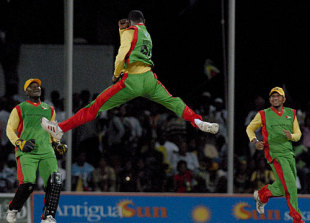'Stanford 20/20 cannot contribute to West Indies' revival'
"If the Standford 20/20 is also being marketed as a means of contributing to the revival of the West Indies as a competitive force, especially in Test cricket, then that claim seems very wide down the leg-side," writes Fazeer Mohammed
Fazeer Mohammed
13-Feb-2008

| ||
What to make of this second Stanford 20/20 tournament?
It's certainly entertaining, occasionally exciting, sometimes amusing, and for those so preoccupied, even titillating. As a stand-alone event it has everything to attract a better than decent regional and international audience with world-class television coverage embellishing a tight, compact package overflowing with action and antics on and off the field.
During the last few days of the West Indies tour of South Africa, it was interesting to note how many fans were enjoying watching the matches, which were shown as one-hour highlights mere hours after each fixture on one of the many sporting cable stations over there. Several commented favourably on how involved and expressive the crowds at the Stanford Cricket Ground have been, or how much they loved the wicket-taking celebration of such-and-such bowler.
Make no mistake, the 2008 edition of the Stanford 20/20 tournament is a really big hit, both at home and abroad, as a television spectacle. But, for all that, and the considerable amount of prize money that alone makes it a major attraction, there is precious little to suggest that the competition is contributing in any meaningful way to the improvement of standards in West Indies cricket, which has been one of the claims of the organisers of this elaborate and very expensive exercise.
While the money given to the respective territorial cricket boards for the preparation of their teams, to say nothing of the fully professional squads like Antigua/Barbuda, would be most welcome in an environment where such financial support is chronically deficient, is there anything to suggest that the unbridled passion and enthusiasm displayed every night under lights will translate into a better quality of play by Caribbean cricketers in the longer forms of the game?
And that really is the crux of the matter. If the event is to be measured solely for its entertainment value, then the organisers must be commended for tapping into a winning formula by blending the increasingly popular Twenty20 form of the game with West Indian style, flair and exuberance on the field and beyond the boundary. But if it is also being marketed as a means of contributing to the revival of the West Indies as a competitive force, especially in Test cricket, then that claim seems very wide down the leg-side.
| Money can buy almost anything, even credibility. But like the emperor with no clothes, the plain truth is there for all to see, at least those who are not blinded by the bright lights and the dollar signs | |||
Again, the assumption here is that Test cricket remains the ultimate standard, the real proving ground of all the attributes of the complete player. Indeed, the men who comprise the celebrated list of "Legends" are all hailed as unquestionable giants of the game on the basis of their great deeds in the five-day version. Of course, there is no reason to doubt that the likes of Garry Sobers and Vivian Richards would not have also excelled were Twenty20 around in their prime.
Still, almost every cricketer of note, either past or present, and even the relatively ordinary ones, that I have ever broached the topic with insist that there is nothing like Test cricket to separate the men from the boys. So, taking the pre-eminence of the longest form of the game as a given, where is the evidence that points to the Stanford 20/20, or any other version of Twenty20 cricket around the world for that matter, being a significant tool for the re-engineering of a struggling team into a real force at Test and one-day international level once again?
Since the thrilling finale to the inaugural Stanford 2020 tournament 18 months ago, when Allen Stanford proclaimed that "West Indies cricket is back on track!", the team has won one of ten Tests and 20 of 44 ODIs, including series victories in Ireland, England and Zimbabwe in the latter half of last year. Can that shock Test victory at the start of the series in South Africa, together with the comparably better performances in 50-over cricket, be attributed in any way to the Twenty20 stuff?
In the first three rounds of this year's regional first-class competition, the average total per innings was less than 220. It is ludicrous to suggest that the final three rounds, following the Stanford tournament, will result in a marked improvement in run-scoring and occupation of the crease. But even in the unlikely event that it does, can that be attributed to the positive impact of night-time vupping sessions?
There is an obvious feel-good factor associated with the Stanford 20/20. The fans always appear deliriously happy. There is a strong emphasis on accentuating the positive and minimising the negative, even in the face of the blindingly obvious inadequacy of a side like Bermuda, a team that, believe it or not, played at the World Cup last year. And Allen is always around and about, making himself very visible to the camera's roving eye, whether it's high-fiving with spectators, encouraging players in the dressing room or old talking with this or that "Legend".
This is as much about putting on a show as staging a cricket competition. Like the fashion runway, appearances are everything, from the bowler wiggling his hips after taking a wicket to the singing, prancing, wining masses who seem to have more energy than many of the players.
Money can buy almost anything, even credibility. But like the emperor with no clothes, the plain truth is there for all to see, at least those who are not blinded by the bright lights and the dollar signs.